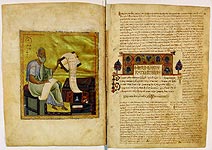Tetraevangelion with Commentary.
1061. Scribe: Monk Nikolay
F (256 ı 180). 357 leaves.
Parchment. Ink, colours, gold.
It is written in a minuscule hand. Scholia are framed the text on three sides; in scholia the commented text is highlighted by cinnabar.
There are 4 full page miniatures (fols. 13v, 123v, 178v, 270v), 4 multicolour ornamental head-pieces with gold, 5 multicolour ornamental initials with gold and 1 one-colour ornamental initial letter, 3 ornamental one-colour frames, 10 frames specifically for the Canon Tables, ornamental delimiters and tail-pieces.
The scribe's inscription on folio 3v says that he completed his work on copying the manuscript on 1 November in 1061. Folios 5r bears the notice of Eugene Bulgaris, a Greek theologian, stating that he acquired this book in 1757 from the Celibate Priest Saphrony in exchange for a promise to erect a chapel in honour of Saint Spyridon in his cell at the cloister of St Paul. The manuscript has complex contents. In addition to the Four Gospels, it contains a vast complementary tool: a preface, headings, an epigram about the Evangelists, as well as extensive scholia of the Antiochian version with a commentary on Gospels. Details from the contents of the manuscript allow to suppose that it was created for private worship. Portraits of the Evangelists in the Four Gospels represent the direction in the Byzantine art of the third quarter of the 11th century, which was based on classical traditions but, at the same time, aimed to made classical forms more spiritual. The ornamental design of the book reflects the developed stage of the petal style.
In 1806 the manuscript came into the Imperial Public Library with the Zaluskis' collection.
Shelfmark: –Õ¡. √˜. 72.





